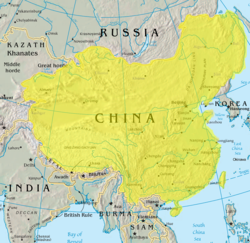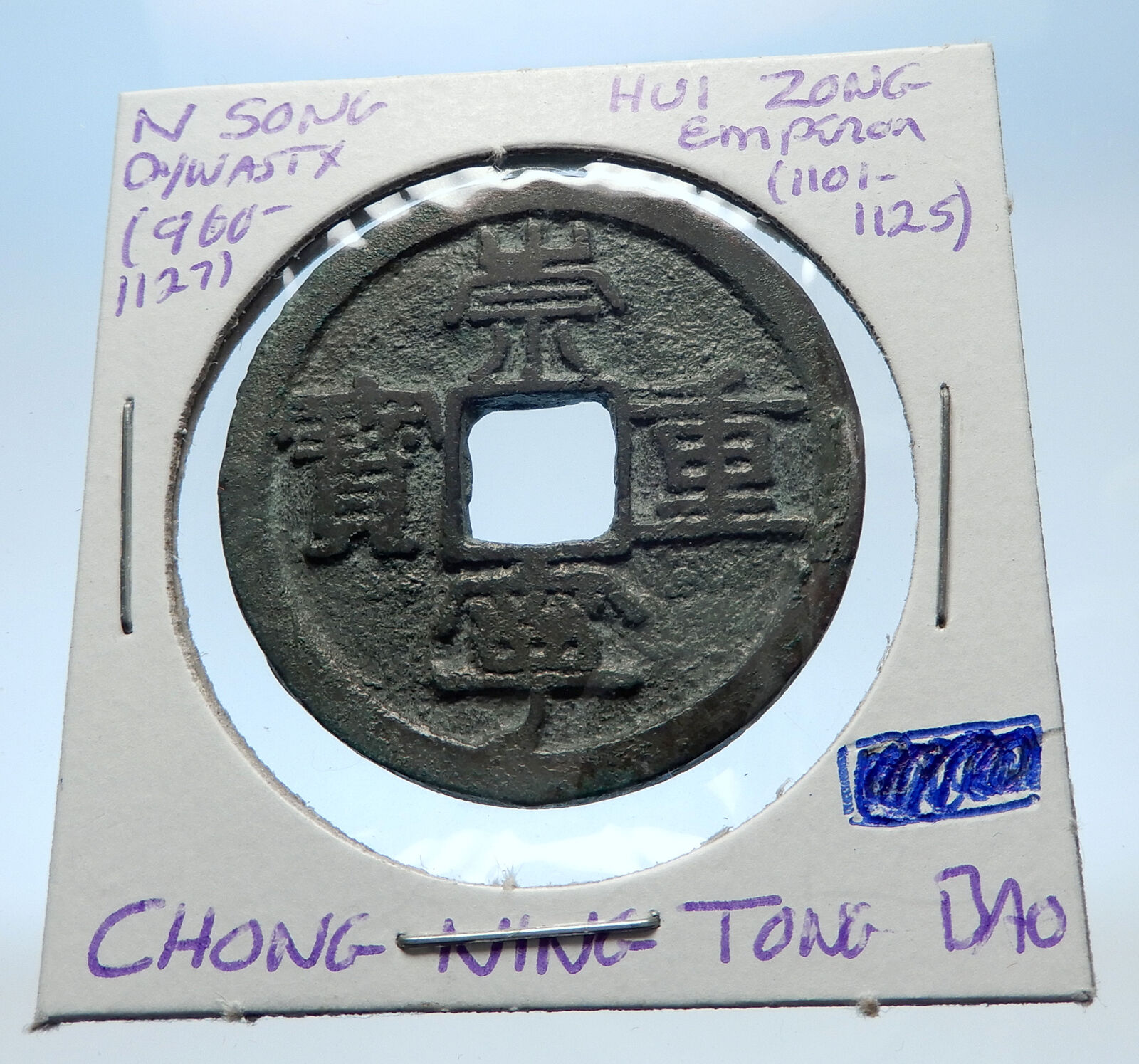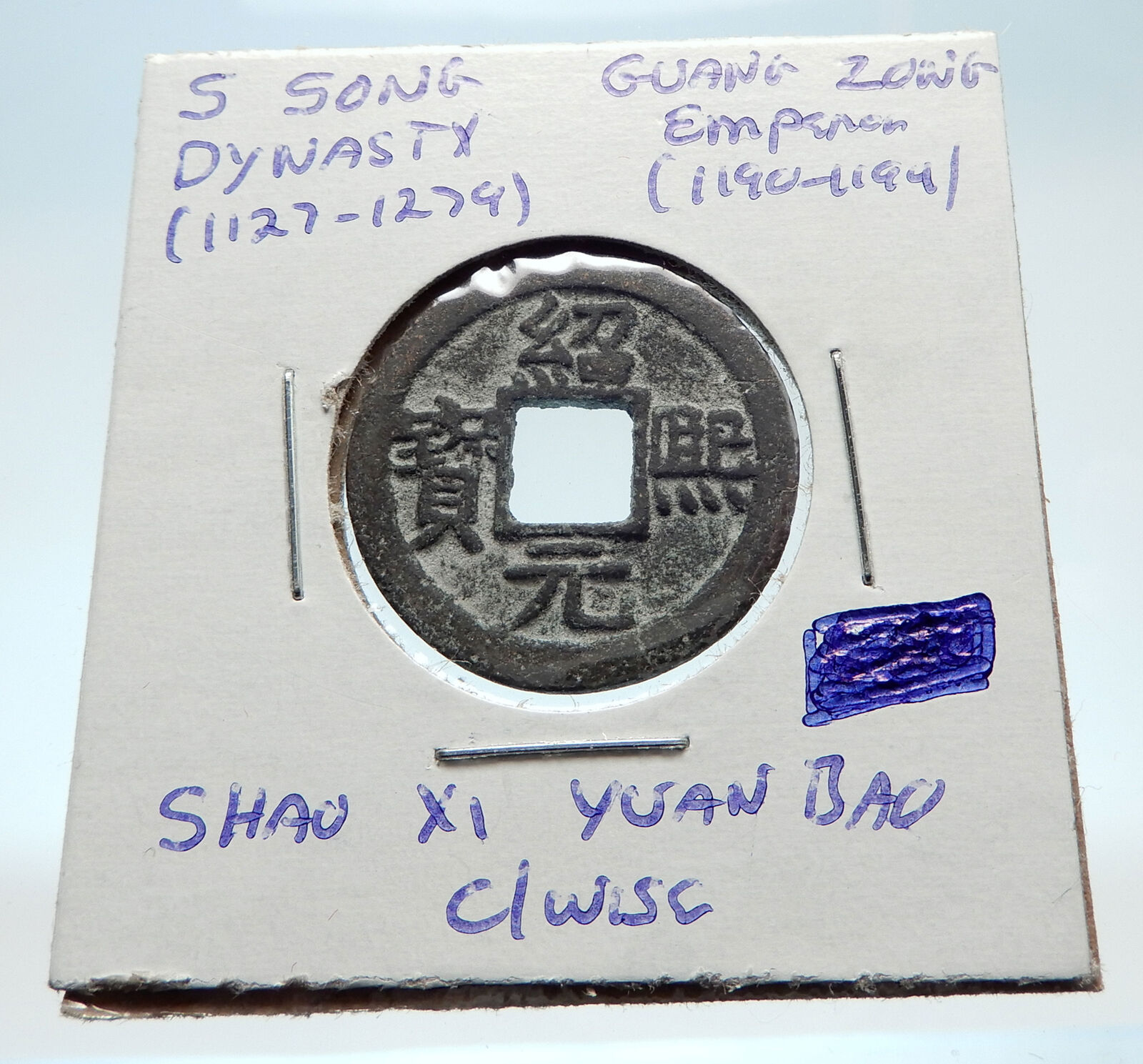|
China – Qing Dynasty (1644-1912 A.D.)
Mu Zong – Emperor: 1862-1874 A.D.
Bronze Cash 21mm
You are bidding on the exact item pictured, provided with a Certificate of Authenticity and Lifetime Guarantee of Authenticity.
Cash was a type of coin of China and East Asia, used from the 4th century BC until the 20th century AD. Originally cast during the Warring States period, these coins continued to be used for the entirety of Imperial China as well as under Mongol, and Manchu rule. The last Chinese cash coins were cast in the first year of the Republic of China. Generally most cash coins were made from copper or bronze alloys, with iron, lead, and zinc coins occasionally used less often throughout Chinese history. Rare silver and gold cash coins were also produced. During most of their production, cash coins were cast but, during the late Qing dynasty, machine-struck cash coins began to be made. As the cash coins produced over Chinese history were similar, thousand year old cash coins produced during the Northern Song dynasty continued to circulate as valid currency well into the early twentieth century.
In the modern era, these coins are considered to be Chinese “good luck coins”; they are hung on strings and round the necks of children, or over the beds of sick people. They hold a place in various superstitions, as well as Traditional Chinese medicine, and Feng shui. Currencies based on the Chinese cash coins include the Japanese mon, Korean mun, Ryukyuan mon, and Vietnamese văn.
 The Tongzhi Emperor (27 April 1856 – 12 January 1875), born Zaichun of the Aisin Gioro clan, was the tenth emperor of the Manchu-led Qing dynasty, and the eighth Qing emperor to rule over China proper. His reign, from 1861 to 1875, which effectively lasted through his adolescence, was largely overshadowed by the rule of his mother, Empress Dowager Cixi. Although he had little influence over state affairs, the events of his reign gave rise to what historians call the “Tongzhi Restoration”, an unsuccessful attempt to stabilise and modernise China. The Tongzhi Emperor (27 April 1856 – 12 January 1875), born Zaichun of the Aisin Gioro clan, was the tenth emperor of the Manchu-led Qing dynasty, and the eighth Qing emperor to rule over China proper. His reign, from 1861 to 1875, which effectively lasted through his adolescence, was largely overshadowed by the rule of his mother, Empress Dowager Cixi. Although he had little influence over state affairs, the events of his reign gave rise to what historians call the “Tongzhi Restoration”, an unsuccessful attempt to stabilise and modernise China.
The only surviving son of the Xianfeng Emperor and Empress Dowager Cixi, the Tongzhi Emperor attempted political reform in the period of the Tongzhi Restoration. His first regnal name was Qixiang (祺祥; Manchu: Fengšengge Sabingga), but this name was later abandoned by Cixi in favour of “Tongzhi”, a contraction of the classical phrase tong gui yu zhi (同归与治; 同歸與治), which means “restoring order together”.[citation needed] An alternate interpretation reads it as “mother and son co-emperors” (母子同治天下),[citation needed] which fits the state of affairs, as the empress dowager wielded real power and ruled behind the scenes. The traditional Chinese political phrase “attending audiences behind a curtain” (垂帘听政; 垂簾聽政; chuí lián tīng zhèng) was coined to describe Cixi’s rule through her son.
The Tongzhi Emperor became emperor at the age of five upon the death of his father, the Xianfeng Emperor. His father’s choice of regent, Sushun, was removed in favour of a partnership between his mother Empress Dowager Cixi, Empress Dowager Ci’an, and his sixth uncle Prince Gong.
While there had most likely been hopes that the Tongzhi Emperor would become a leader like the Kangxi Emperor (who ascended the throne as a child in 1661), those hopes would soon come to naught, as the Tongzhi Emperor grew up to become an obstinate and dissolute young man.
In the fall of 1872, the teenage emperor married Empress Xiaozheyi and several concubines. The Tongzhi Emperor apparently had wanted to take up power immediately, prompting a quarrel at court regarding the dismantling of the regency and the timing of it. However, the two empresses dowager stuck by the intended date of February 23, 1873.
The day after the Tongzhi Emperor took up the reins of power, the foreign powers requested an audience with the teenage emperor. The request precipitated a sharp disagreement between the ministers at the foreign legations, who made it clear that they would not perform the ritual kowtow to the emperor, and the Zongli Yamen (foreign affairs ministry), regarding the protocol to be observed. The Qing government was also loath to hold the audience within the confines of the Forbidden City, eventually settling on the “Pavilion of Purple Light” at one of the lakeside palaces to the west of the Forbidden City, which is now part of Zhongnanhai. The audience was finally held on 29 June 1873. After the audience, however, the foreign representatives made clear their annoyance at being received in a hall initially used by the Qing emperors to receive envoys of tributary states.
In the fall of 1874, the Tongzhi Emperor got into a clash with his ministers, which included his two uncles, Prince Gong and Prince Chun, largely over the emperor’s plans to rebuild the Old Summer Palace at a time in which the empire was bankrupt, and over his dissolute behavior. The emperor reacted by firing the ministers, but Empresses Dowager Ci’an and Cixi intervened, and he had them reinstated. That December, it was announced that he was ill with smallpox, and the empresses dowager resumed the regency. He died on 12 January 1875, leaving no sons to succeed him.
The Tongzhi Emperor’s death left the court in a succession crisis, as, although he was childless, his empress was reportedly pregnant. Eventually, the empresses dowager designated the Tongzhi Emperor’s three-year-old cousin, Zaitian, as the heir to the throne. Zaitian was biologically Prince Chun’s son, but was symbolically adopted as the Xianfeng Emperor’s son to make him eligible to succeed the Tongzhi Emperor. Zaitian was thus enthroned as the Guangxu Emperor, with Empresses Dowager Ci’an and Cixi resuming their roles as regents. The Tongzhi Emperor’s empress died a few months later.
Taiping Rebellion
Hong Xiuquan (1814-1864) was peculiarly affected by the social instability of the Canton region. He belonged to a family of modesty well-off peasants from Hua county north of Canton, members of the Hakka community ubiquitous in the region. Hong combined both the Confucian idea and Western Christianity idea to start his Taiping Rebellion. In late 1851, Taiping army occupied its first walled city Yongan.
When 5-year-old Tongzhi Emperor ascend the throne in 1861, the Taiping rebellion was threatening Shanghai. This move prompted several foreign missions of British, French, and Americans to the Heavenly Capital, to warn the Taiping against interference with Western commerce. Foreign neutrality was beginning to fray as Western intelligence of the Taiping revealed both its unorthodox religious ideology and its lack of understanding of the Western world. In order to save Shanghai, Tongzhi Emperor ordered Zeng Guofan to counter-attack the rebel. Zeng’s appointment was the turning point in the Taiping war. Zeng was a virtual generalissimo directing a supra-provincial campaign by armies raised and led by his various lieutenants and proteges, supported by the extrodinary mobilization of revenues including the likin tax and customs revenues. His strategy was to move from the west down the Yangzi taking succesive cities, while Li Hongzhang, his principal lieutenant, advanced from the east through Jiangsu toward Nanjing.
The Heavenly Capital fell in July 1864. Hong Xiuquan was already dead, on June 1, 1864. The fall of the city was followed by a great massacre. Remnant Taiping forces fled south, including Hong’s son the Junior King and Hong Rengan, to continue the movement, but both were soon captured and executed. The last Taiping forces were destroyed in Guangdong in early 1866, having come geographically almost full circle in the course of fifteen years.
The Self-Strengthening Movement
The inspiration for the Self-Strengthening Movement from the 1840s arose from this notion that China’s defense in the face of war and rebellion must come from within, as the superior man strengthens himself under imperative of Heaven’s robust action. the costs of war and rebellion dictated that Qing dynasty undertake vigorous measures to ensure its survival. Moreover, the very survival of China itself was now at stake. But the problem was that neither the authority of the Yi Jing nor the teachings of history sanctioned the sort of radical change that now was called for.
Self-strengthening efforts evolved in a succession of stages over a period of almost half a century. In 1840 Imperial Commissioner Lin Zexu, impressed by the power of British warships in the initial battles of the Opium War, advocated adoption of Western naval technology. The paddle-wheel steamer Nemsis had run circles around cumbersome Chinese war junks. Some Chinese at first believed the paddle-wheels were powered by men inside the ship, but soon came to appreciate the power of steam, Commisioner Lin was the first self-strengthener. But the appreciation of Western military technology was limited to a very few officials on the scene who were isolated in the vast conservative bureaucracy. Lin’s proposals fell on deaf ears. The Court simply did not believe that an emergency existed that could not be handled in the traditional way of reemphasizing the moral values of humanity (ren) and righteousness (yi).
Self-strengthening enterprises, including arsenals, shipyards, and technical schools, were now established in the principal treaty ports where access to Western technology was most direct. Funds to support these projects were diverted from likin tax on goods in transit and from customs revenue. Even the imperialist powers, fearful that their hard-won commercial privileges would be jeopardized if the dynasty collapsed, offered their support. Still, few scholar-officials were persuaded of the necessity of the adoption of Western technology; commitment to traditional learning as a priority remained as strong as ever.
The Qing dynasty, also known as the Qing Empire, officially the Great Qing, was the last imperial dynasty of China, established in 1636 and ruling China from 1644 to 1912. It was preceded by the Ming dynasty and succeeded by the Republic of China. The Qing multi-cultural empire lasted almost three centuries and formed the territorial base for the modern Chinese state. It was the fourth largest empire in world history.

Qing Empire, 1765
The dynasty was founded by the Jurchen Aisin Gioro clan in Manchuria. In the late sixteenth century, Nurhaci, originally a Ming vassal, began organizing “Banners”, military-social units that included Jurchen, Han Chinese, and Mongol elements. Nurhaci formed the Jurchen clans into a unified entity, which he renamed as the Manchus. By 1636, his son Hong Taiji began driving Ming forces out of Liaodong and declared a new dynasty, the Qing. In 1644, peasant rebels led by Li Zicheng conquered the Ming capital, Beijing. Rather than serve them, Ming general Wu Sangui made an alliance with the Manchus and opened the Shanhai Pass to the Banner Armies led by the regent Prince Dorgon, who defeated the rebels and seized the capital. Resistance from the Southern Ming and the Revolt of the Three Feudatories led by Wu Sangui delayed the Qing conquest of China proper by nearly four decades. The conquest was only completed in 1683 under the Kangxi Emperor (r. 1661-1722). The Ten Great Campaigns of the Qianlong Emperor from the 1750s to the 1790s extended Qing control into Inner Asia. The early Qing rulers maintained their Manchu customs, and while their title was Emperor, they used “Bogd khaan” when dealing with the Mongols and they were patrons of Tibetan Buddhism. They governed using Confucian styles and institutions of bureaucratic government and retained the imperial examinations to recruit Han Chinese to work under or in parallel with Manchus. They also adapted the ideals of the tributary system in dealing with neighboring territories.
During the Qianlong reign (1735-96) the dynasty reached its apogee, but then began its initial decline in prosperity and imperial control. The population rose to some 400 millions, but taxes and government revenues were fixed at a low rate, virtually guaranteeing eventual fiscal crisis. Corruption set in, rebels tested government legitimacy, and ruling elites failed to change their mindsets in the face of changes in the world system. Following the Opium War, European powers imposed “unequal treaties”, free trade, extraterritoriality and treaty ports under foreign control. The Taiping Rebellion (1850-64) and the Dungan Revolt (1862-77) in Central Asia led to the deaths of some 20 million people, most of them due to famines caused by war. In spite of these disasters, in the Tongzhi Restoration of the 1860s, Han Chinese elites rallied to the defense of the Confucian order and the Qing rulers. The initial gains in the Self-Strengthening Movement were destroyed in the First Sino-Japanese War of 1895, in which the Qing lost its influence over Korea and the possession of Taiwan. New Armies were organized, but the ambitious Hundred Days’ Reform of 1898 was turned back in a coup by the conservative Empress Dowager Cixi. When the Scramble for Concessions by foreign powers triggered the violently anti-foreign “Boxers”, the foreign powers invaded China, Cixi declared war on them, leading to defeat and the flight of the Imperial Court to Xi’an.
After agreeing to sign the Boxer Protocol, the government initiated unprecedented fiscal and administrative reforms, including elections, a new legal code, and abolition of the examination system. Sun Yat-sen and other revolutionaries competed with reformist monarchists such as Kang Youwei and Liang Qichao to transform the Qing Empire into a modern nation. After the deaths of Cixi and the Guangxu Emperor in 1908, the hardline Manchu court alienated reformers and local elites alike by obstructing social reform. The Wuchang Uprising on October 11, 1911, led to the Xinhai Revolution. General Yuan Shikai negotiated the abdication of Puyi, the last emperor, on February 12, 1912. The Qing Empire was briefly restored on July 1, 1917, before it was once again overthrown 12 days later.
|




 The Tongzhi Emperor (27 April 1856 – 12 January 1875), born Zaichun of the Aisin Gioro clan, was the tenth emperor of the Manchu-led Qing dynasty, and the eighth Qing emperor to rule over China proper. His reign, from 1861 to 1875, which effectively lasted through his adolescence, was largely overshadowed by the rule of his mother, Empress Dowager Cixi. Although he had little influence over state affairs, the events of his reign gave rise to what historians call the “Tongzhi Restoration”, an unsuccessful attempt to stabilise and modernise China.
The Tongzhi Emperor (27 April 1856 – 12 January 1875), born Zaichun of the Aisin Gioro clan, was the tenth emperor of the Manchu-led Qing dynasty, and the eighth Qing emperor to rule over China proper. His reign, from 1861 to 1875, which effectively lasted through his adolescence, was largely overshadowed by the rule of his mother, Empress Dowager Cixi. Although he had little influence over state affairs, the events of his reign gave rise to what historians call the “Tongzhi Restoration”, an unsuccessful attempt to stabilise and modernise China. 





